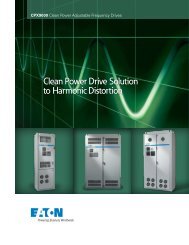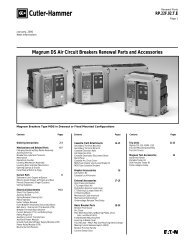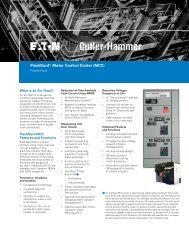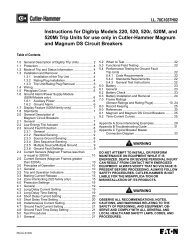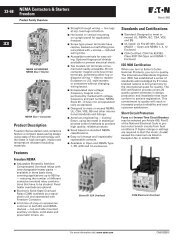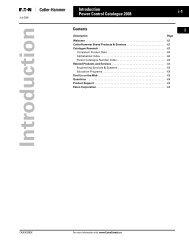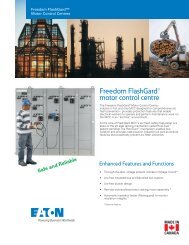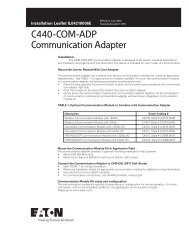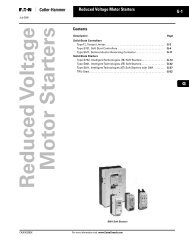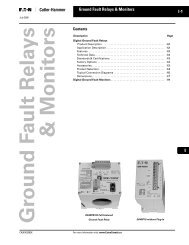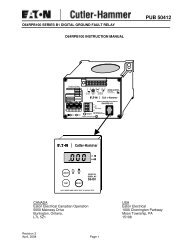molded case circuit breakers - Eaton Canada
molded case circuit breakers - Eaton Canada
molded case circuit breakers - Eaton Canada
You also want an ePaper? Increase the reach of your titles
YUMPU automatically turns print PDFs into web optimized ePapers that Google loves.
Originally a Westinghouse Product<br />
March 2001<br />
181<br />
Page Product 1945 1950 1960 1965 1970 1975 1980 1985 1990 1995 Present<br />
182 ASR Relay Slipsyn (Brush Type)<br />
184<br />
190<br />
Mark I Static Slipsyn (Brush Type)<br />
Mark II Static Slipsyn (Brush Type)<br />
Mark V Static Slipsyn<br />
Brushless Motor Control<br />
SYNCHRONOUS MOTOR CONTROL<br />
Relay or Solid-State Mark V Slipsyn<br />
Motor<br />
Control for Brush and Brushless Motors<br />
PRODUCT DESCRIPTION<br />
Synchronous Motors<br />
Polyphase synchronous motors are<br />
employed primarily to obtain high pullout<br />
torques, constant operating speed or generation<br />
of leading reactive kVA for Power<br />
Factor (PF) correction. To bring a motor to a<br />
constant speed, DC power is applied to a<br />
special winding in a synchronous motor.<br />
This winding is called a field coil winding<br />
and is controlled by ”field control.“ DC power<br />
for a brush type motor is usually supplied<br />
with the starter and entails using an exciter.<br />
DC power for a brushless type motor is<br />
supplied by an exciter mounted on the<br />
motor. Refer to pages 182 and 183 for<br />
further description of brush and brushless<br />
type motors.<br />
Synchronous Motor Control —<br />
Westinghouse Slipsyn<br />
Synchronous motor ”field application<br />
PRODUCT HISTORY<br />
Synchronous Motor Control<br />
Westinghouse has offered brush type<br />
synchronous field control since the 1940s.<br />
Motor starters for brushless synchronous<br />
motors have been offered since the late<br />
1960s. Synchronous motors can be medium<br />
voltage (2300 – 7200V) or low voltage<br />
(600V and below). A synchronous motor<br />
starter includes the basic motor control<br />
PLUS the synchronous control and protection<br />
functions. Typically, the basic motor<br />
control and the field application control<br />
are mounted in separate compartments<br />
within the starter. Ratings of synchronous<br />
control are in terms of the maximum<br />
DC field amperes required by the motor.<br />
Current ratings are 45, 90, 135, 160, 200<br />
and 270A DC, through 6000 HP and 5 kV.<br />
Relay and Solid-State Type Control<br />
Relay type Slipsyn was introduced in 1947<br />
and uses the ASR synchronizing relay.<br />
This type of control is still available and<br />
used today. Forms of solid-state type<br />
Slipsyn were introduced in the late ‘50s<br />
and early ‘60s but were not completely<br />
solid-state and had some of the operation<br />
problems the relay type control encountered.<br />
These were called Mark I and Mark II<br />
Static Slipsyn. In 1989 the Mark V Solid-<br />
State Slipsyn field control was introduced.<br />
PRODUCT HISTORY TIMELINE<br />
control“ generally includes a synchronous<br />
device to apply DC power to the motor<br />
field <strong>circuit</strong> at the optimum speed. It may<br />
also include protective features such as<br />
locked rotor protection, failure to synchronize,<br />
incomplete sequence, field failure,<br />
pull-out protection, etc. depending on the<br />
type of field application control selected.<br />
Refer to pages 182 and 183 for further<br />
description on the control required for<br />
brush and brushless type motors.<br />
Relay Type vs. Solid-State Type — Mark V<br />
Relay Type<br />
The relay type uses the ASR synchronizing<br />
relay. Inherent in using the relay type are<br />
the problems that are associated with using<br />
contacts or mechanical closing devices such<br />
as arcing, spring and bearing deterioration<br />
and wear, dirty atmospheres etc.<br />
Medium Voltage (AMPGARD) Starters<br />
The AMI AMPGARD synchronous starter<br />
(1957–1970) used a 60-inch deep enclosure<br />
with the synchronous control in the low<br />
voltage section in the front bottom 2/3 of<br />
the starter enclosure. The basic motor control<br />
was located in the rear bottom 2/3 of<br />
the enclosure, barriered off from the low<br />
voltage section. The AMI AMPGARD for<br />
synchronous motors used the ASR<br />
relay type control.<br />
The LF AMPGARD (1962–1988) primarily<br />
used the ASR field application relay control.<br />
Mark I and Mark II Static Slipsyn were<br />
also used during their availability periods.<br />
The LF AMPGARD for synchronous motors<br />
included the basic induction motor control<br />
(ISO switch, contactor and starter control)<br />
in the bottom half of the structure. The<br />
upper half contained the step down static<br />
excitation transformer with current limiting<br />
fuses, the Silicon Controlled Rectifier<br />
(SCR) type static exciter and the synchronizing<br />
control and motor field protection<br />
panel.<br />
The SJ AMPGARD (1982 – 2000) family of<br />
synchronous control is very similar to the<br />
LF AMPGARD. Until the availability of the<br />
Mark V solid-state synchronous control,<br />
the SJ used the ASR relay type field con-<br />
Solid-State — Mark V<br />
The Mark V is 100% solid-state and<br />
features a ”soft-turn-on“ <strong>circuit</strong> which<br />
applies DC field voltage to the motor field.<br />
It enables all required functions for correct<br />
synchronization to be accomplished<br />
without the use of moving contacts or<br />
mechanical closing devices.<br />
With the Mark V, the static exciter power<br />
supply is always supplied and is part of<br />
the ”system.“<br />
Also available as a modification with<br />
the Mark V is a VAR/PF/DC field current<br />
regulator. The regulator consists of a<br />
printed <strong>circuit</strong> board, auxiliary devices<br />
and potentiometers for adjustment.<br />
trol. With the advent of the Mark V, 90% of<br />
the synchronous starters are supplied<br />
with this type control. In both ASR and<br />
Mark V control schemes the synchronous<br />
gear is usually mounted in the top half of<br />
the starter.<br />
Low Voltage Synchronous Starters<br />
Low voltage synchronous starters are<br />
similar in nature to high voltage synchronous<br />
starters except in two regards.<br />
High voltage starters, unlike low voltage<br />
starters, must isolate the low voltage from<br />
the high voltage. The components for the<br />
field control are the same.<br />
The second difference lies in the primary<br />
disconnect used in the starters. Low-voltage<br />
starters can be supplied with no short<br />
<strong>circuit</strong> protection, with a non-fusible disconnect,<br />
a fusible disconnect switch or<br />
with a <strong>molded</strong> <strong>case</strong> <strong>circuit</strong> breaker. Low<br />
voltage synchronous starters were manufactured<br />
in the late ‘40s, with the introduction<br />
of the ASR relay, until September of<br />
1989. In 1991 the product was reintroduced<br />
using the Mark V solid-state field<br />
control. Marketing for the current line is<br />
handled in Asheville, NC. The starters are<br />
manufactured in Fayetteville, NC.<br />
M



